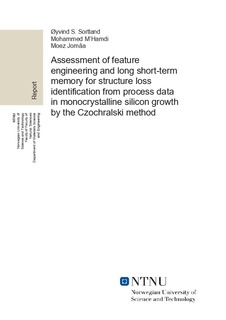| dc.contributor.author | Sortland, Øyvind Sunde | |
| dc.contributor.author | M'hamdi, Mohammed | |
| dc.contributor.author | Jomâa, Moez | |
| dc.date.accessioned | 2019-12-19T09:19:53Z | |
| dc.date.available | 2019-12-19T09:19:53Z | |
| dc.date.created | 2019-12-18T10:33:17Z | |
| dc.date.issued | 2019 | |
| dc.identifier.uri | http://hdl.handle.net/11250/2634087 | |
| dc.description.abstract | Structure loss impairs the quality of monocrystalline ingots and represents a major productivity loss for crystal growers. If structure loss could be predicted in advance it could help reduce the lost production time or preventive measures could be initiated. For this reason, feature engineering and machine learning by long short-term memory (LSTM) is used to assess if structure loss could be predicted from sensor data collected during growth of ingots. The method is not able to predict structure loss in advance, and the predictions may likely be based on the length of the signal, which is shortened for structure loss ingots as their growth is interrupted, and not actual features in the sensor readings. | nb_NO |
| dc.language.iso | eng | nb_NO |
| dc.publisher | Department of Materials Science and Engineering, NTNU | nb_NO |
| dc.title | Assessment of feature engineering and long short-term memory for structure loss identification from process data in monocrystalline silicon growth by the Czochralski method | nb_NO |
| dc.type | Research report | nb_NO |
| dc.description.version | submittedVersion | nb_NO |
| dc.source.pagenumber | 16 | nb_NO |
| dc.identifier.cristin | 1762361 | |
| dc.relation.project | Norges forskningsråd: 257639 | nb_NO |
| cristin.unitcode | 194,66,35,0 | |
| cristin.unitname | Institutt for materialteknologi | |
| cristin.ispublished | true | |
| cristin.fulltext | preprint | |
